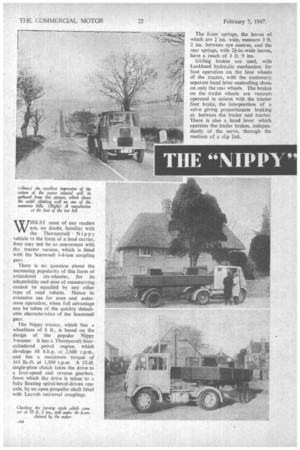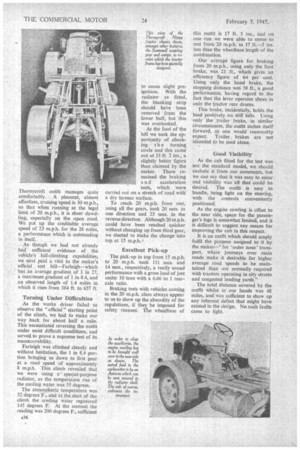THE "NIPPY' FLATTENS HILLS
Page 52

Page 53

Page 54

If you've noticed an error in this article please click here to report it so we can fix it.
Thornycroft Tractor Outfit .Puts Up a Sound Performance With a Gross Load of Nearly Io Tons WHILST most of our readers are, no doubt, familiar with the Thornycroft Nippy vehicle in the form of a load carrier, they may not be so conversant with the tractor version, which is fitted with the Scan-aria 6-8-ton coupling gear.
There is no question about the increasing popularity of this form of articulated six-wheeler, for its adaptability and ease of rnanceuvring cannot be equalled by any other type of road vehicle. Hence its extensive use for zone and outerzone operation, when full advantage can be taken of the quickly detachable characteristics of the Scamrnell gear. '
The Nippy tractor, which has a wheelbase of 8 ft., is based on the design of the popular Nippy 3-tonner. It has a Thornycroft fourcylindered petrol engine, which develops 68 b.h.p. at 2,600 r.p.m., and has a maximum torque of 163 lb.-ft. at 1,500 r.p.m. A l2-i. single-plate clutch takes the drive to a four-speed and reverse gearbox, from which the drive is taken to a fully floating spiral-bevel-driven rear axle, by an open propeller shaft fitted with Layrub universal couplings The front springs, the leaves of which are 2 ins, wide, measure 3 ft. 2 ins, between eye Centres, and the rear springs, with 2i-in.-wide leaves, have a reach of 3 ft. 9 ins.
Girling brakes are used, with Lockheed hydraulic mechanism for foot operation on the four wheels Of the tractor, with the customary separate hand lever controlling shoes on only the rear wheels. The brakes on the trailer wheels are vacuum operated in unison with the tractor foot brake, the interposition of a valve giving proportionate braking as between the trailer and tractor. There is also a hand lever which operates the trailer brakes, independently of the servo, through the medium of a slip link.
The rear of the tractor frame is designed to accommodate the wellknown geammell coupling and brake gear, that fitted to the Nippy being for 6to 8-ton loads As driven away from the Thornycroft works at Basingstoke, our grins load was 9 tons lq cwt., the payload weighing 6 tons 1 cwt, or 61 57 per cent. of the total.
A more practicable, but probably less spectacular, form of road test for an outfit of this type would be to see it through a normal day's work in the hands of its operator it would certainly have an easier time than it did while in our hands, as we took it straight away on a 28-mile circuit which included 10 hills, each of which served to prove that the Thornycroft engine, in conjunction with well-chosen gear ratios, was master of its load without our having to drop down to an unusually low road speed. Reference to the accompanying route map will show the gradients of the various hills, from which it will be seen that Bullington Cross has ..a maximum gradient of 1 in 9. This hill. as was most of the others, was
m.p.g., as good as it is, is capable of being improved by probably 10 per cent, under normal operating conditions.
The maximum speed held on this run was 35 m.p.h., and this the Thornycroft outfit manages quite comfortably. A pleasant, almost effortless, cruising speed is 30 m.p.h., so that when running at the legal limit of 20 m.p.h., it is sheer dawdling, especially on the open road. We put up the creditable average speed of 23 m.p.h. for the 28 miles, a performance which is outstanding in itself.
As though we had not already had sufficient evidence of the vehicle's hill-climbing capabilities, we next paid a visit to the maker's official test hill—Farleigh7-which has .an average gradient of 1 in 27, a maximum gradient of 1 in 8.4, and an observed length of 1.4 miles in which it rises from 384 ft. to 657 ft.
Turning Under Difficulties
As the works driver failed to observe the "official" starting point of the climb, we had to make our way back for about half a mile. This necessitated reversing the outfit under most difficult conditions, and served to prove a supreme test of its manceuvrability.
Farleigh was climbed cleanly and without hesitation, the 1 in 8.4 portion bringing us down to first gear at a road speed of approximately 8 m.p.h. This climb revealed that we were using aspecial-purpose radiator, as the temperature rise of the cooling water was 55 degrees.
The atmospheric temperature was 32 degrees F., and at the start of the climb the cooling water registered 145 degrees F. At the summit the reading was 200 degrees F., sufficient to cause slight preignition. With the radiator as fitted, the blanking strip should have been removed from the lower half, but this was overlooked.
At the foot of the hill we took the opportunity of checking t h e turning circle and this came out at 33 ft. 2 ins., a slightly better figure than claimed by the maker. There remained the braking
a a d acceleration tests, which were carried out on a stretch of road with a dry tarmac surface.
To reach 20 m.p.h. from rest, using all the gears, took 20 secs. in one direction and 23 secs. in the reverse direction. Although 20 m.p.h. could have been reached quicker without changing up from third gear, we elected to make the change into top at 15 m.p.h.'
Excellent Pick-up
The pick-up in top from 15 m.p.h. to 20 m.p.h. took 1 1 secs. and 14 secs., respectively, a really sound performance with a gross load of just under 10 tons with a 6.66 to 1 rearaxle ratio.
Braking tests with vehicles coming in the 20 m.p.h. class always appear to us to show up the absurdity of the regulations, if they be imposed for safety reasons. The wheelbase of
this outfit is 17 ft. 5 ins., and on one • run we were able to cometo rest from 20 m.p.h. in 17 ft.-5 ins. less than the wheelbase length of the combination.
Our average figure for braking from 20 m.p.h., using only the foot brake, was 21 ft., which gives an efficiency figure of 64 per cent. Using only the hand brake, the stopping distance was 58 ft., a good performance, having regard to the fact that the lever operates shoes in only the tractor rear drums.
This brake, incidentally, holds the load positively on Stiff hills. Using only the ' trailer brake, in similar circumstances, the outfit inches itself forward, as one would reasonably 'expect. Trailer brakes are not intended to be used alone.
Good Visibility
As the cab fitted for the test was not the standard model, we should exclude it from our comments, but we can say that it was easy to enter and visibility was all that could be desired. The outfit is easy to handle, being light on the steering, with the controls conveniently positioned.
As the engine cowling is offset to the near side, space for the passenger's legs is somewhat limited, and it is difficult to suggest any means for improving the cab in this respect.
It is an outfit which should amply fulfil the purpose assigned to it by the maker—" for 'outer zone' transport, where journeys over main roads make it desirable for higher average road speeds to be maintained than are normally required with tractors operating in city streets and congested loading yards."
The total distance covered by the outfit whilst in our hands was 48 miles, and was sufficient to show up any inherent defect that might have existed in the design. No such faults came to light.




















































































